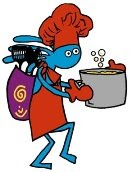Since our Beer Bread Mixes are one of our top sellers, we wanted to share some trivia that we had “dug up” on beer.
Beer is one of the oldest products of civilization, & may even have been a stepping stone to the invention of leavened bread. Historians believe that the ancient Mesopotamians & Sumerians were brewing as early as 10,000 BC. Dr. Solomon Katz theorizes that when man learned to ferment grain into beer, it became one of his most important sources of nutrition. Beer gave people protein that unfermented grain couldn't supply. But in order to have a steady supply of beer, it was necessary to have a steady supply of beer's ingredients. Man had to give up his nomadic ways, settle down, & begin farming. And once he did, civilization was just a stone's throw away.
It is said that the Sumerians discovered the fermentation process by chance. No one knows exactly how this occurred, but it could be that a piece of bread or grain became wet and a short time later, it began to ferment & an inebriating pulp resulted.
The earliest description of the making of beer, found on an ancient engraving in the Sumerian language shows barley, followed by a pictograph of bread being baked, crumbled into water to form a mash, & then made into a drink that is recorded as making people feel "exhilarated, wonderful & blissful." It could be that baked bread was a convenient method of storing & transporting a resource for making beer. The Sumerians had discovered a "divine drink" which certainly was a gift from the gods.
Both sexes & all classes drank beer. It was so important that in the Code of Hammurabi (18th century B.C.), owners of beer parlors who overcharged customers were to be put to death by drowning. On the ancient clay tablets we also read about "bappir", a bread that was used in brewing, but only eaten during food shortages. Bappir conveniently kept the grain from spoiling. Another of these laws established a daily beer ration. This ration was dependent on the social standing of the individual, a normal worker received 2 liters, civil servants 3 liters, administrators and high priests 5 liters per day. In these ancient times beer was often not sold, but used as barter.
In ancient times beer was cloudy & unfiltered. "Drinking straws" were used to avoid getting the brewing residue, which was very bitter, in the mouth.
In the middle ages, European monks were the guardians of literature and science, as well as the art of beer making. They refined the process to near perfection and institutionalized the use of hops as a flavoring and preservative. However, it wasn't until Louis Pasteur came along that a final, important development was made. Until that time, brewers had to depend on wild, airborne yeast for fermentation. By establishing that yeast is a living microorganism, Pasteur opened the gates for accurately controlling the conversion of sugar to alcohol.
While grapes grow well in warm climates, barley grows better in cooler climes. This is how the northern countries of Germany and England became famous for their beers.
Beer was of major concern for revolutionary thinkers like Thomas Jefferson, who quickly passed legislation to create a healthy beer industry in the new United States. Everything went swimmingly until the dark day in 1920 when Prohibition took effect. Many breweries went out of business or switched to the production of soda pop. Of course, not everyone stopped drinking, but gangster-controlled operations were not known for high-quality products.
Late in 1933, Congress passed the 21st Amendment to the Constitution which repealed the unpopular law. However, the new breeds of American beer that came after World War II were generally mass-produced & very bland. Jimmy Carter legalized home brewing, ushering in the age of microbreweries, beer hobbyists, & beer snobs.
